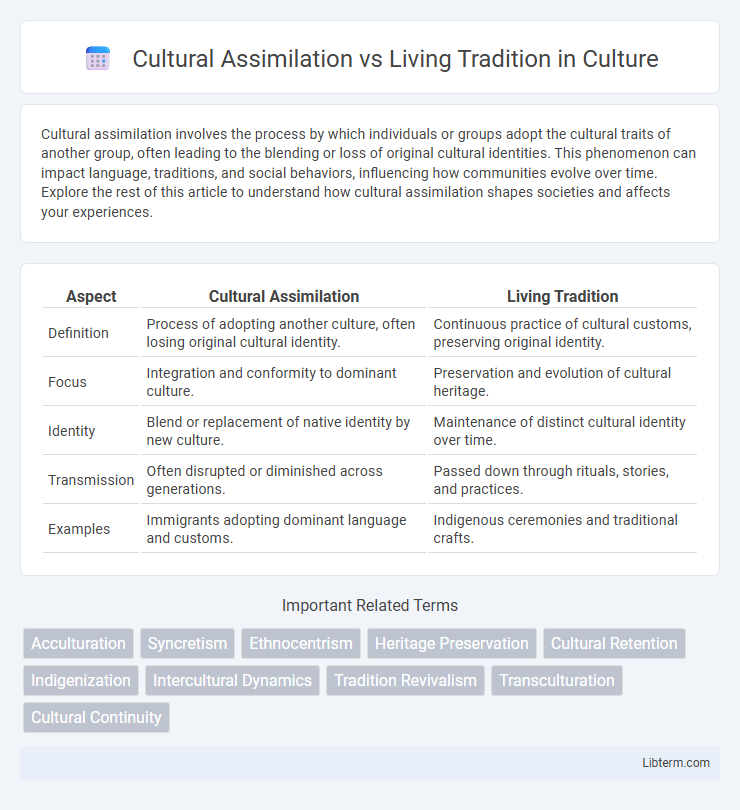Cultural assimilation involves the process by which individuals or groups adopt the cultural traits of another group, often leading to the blending or loss of original cultural identities. This phenomenon can impact language, traditions, and social behaviors, influencing how communities evolve over time. Explore the rest of this article to understand how cultural assimilation shapes societies and affects your experiences.
Table of Comparison
| Aspect | Cultural Assimilation | Living Tradition |
|---|---|---|
| Definition | Process of adopting another culture, often losing original cultural identity. | Continuous practice of cultural customs, preserving original identity. |
| Focus | Integration and conformity to dominant culture. | Preservation and evolution of cultural heritage. |
| Identity | Blend or replacement of native identity by new culture. | Maintenance of distinct cultural identity over time. |
| Transmission | Often disrupted or diminished across generations. | Passed down through rituals, stories, and practices. |
| Examples | Immigrants adopting dominant language and customs. | Indigenous ceremonies and traditional crafts. |
Understanding Cultural Assimilation
Cultural assimilation involves the process by which individuals or groups adopt the cultural traits of another, often dominant, community, resulting in the gradual loss of their original cultural identity. It can lead to the erosion of unique customs, languages, and traditions as minority cultures integrate into mainstream society. Understanding cultural assimilation requires examining power dynamics, social pressures, and the impact on cultural diversity and heritage preservation.
Defining Living Tradition
Living tradition refers to the dynamic process by which cultural practices, values, and expressions are continuously adapted and transmitted within a community, maintaining relevance across generations. Unlike cultural assimilation, which often involves the absorption and loss of distinct cultural identities, living tradition emphasizes preservation through active participation and innovation, ensuring that cultural heritage remains vibrant and meaningful. This concept highlights the evolving nature of culture as both a link to the past and a foundation for future identity formation.
Historical Perspectives on Cultural Change
Historical perspectives on cultural change reveal that cultural assimilation often involves the absorption of minority groups into dominant societies, leading to the loss of original customs and languages. In contrast, living traditions maintain continuity by adapting cultural practices within communities across generations, preserving identity while evolving. Studies of colonial and post-colonial societies highlight how living traditions resist homogenization, fostering resilience through localized adaptation and intergenerational transmission.
Key Differences: Assimilation vs. Tradition
Cultural assimilation involves the process where individuals or groups adopt the cultural traits of another dominant group, often leading to the loss of original cultural identity. Living tradition emphasizes the continuous practice and transmission of cultural customs, values, and knowledge within a community, preserving heritage across generations. Key differences revolve around assimilation's tendency toward cultural blending or erasure, contrasted with living tradition's focus on cultural resilience and ongoing renewal.
The Role of Identity in Cultural Processes
Identity plays a crucial role in cultural assimilation and living tradition by influencing how individuals negotiate between adopting new cultural norms and preserving heritage. In cultural assimilation, identity often shifts as individuals conform to dominant cultural practices, sometimes leading to the loss of original customs. Living tradition, however, emphasizes the dynamic and ongoing expression of cultural identity, allowing communities to adapt traditions while maintaining a continuous link to their historical roots.
Factors Driving Assimilation
Factors driving cultural assimilation include economic opportunities that encourage immigrants to adopt the dominant language and customs, as well as social pressures to conform within educational institutions and workplaces. Media representation and governmental policies promoting integration further accelerate the adoption of mainstream cultural norms. Urbanization and intermarriage also facilitate assimilation by increasing contact and blending between different cultural groups.
Preserving Living Traditions in Modern Societies
Preserving living traditions in modern societies requires actively engaging communities in the continuous practice and adaptation of their cultural rituals, languages, and crafts. Unlike cultural assimilation, which often leads to the erosion of unique identities, sustaining living traditions fosters cultural diversity and strengthens social cohesion. Government policies supporting cultural education, heritage festivals, and intergenerational knowledge transfer play a critical role in maintaining these vibrant, evolving cultural expressions.
Challenges and Controversies
Cultural assimilation often faces challenges such as loss of indigenous identity and linguistic erosion, sparking controversies over forced conformity versus voluntary integration. Living tradition emphasizes the preservation of cultural practices through intergenerational transmission, raising debates about authenticity and adaptation in changing social contexts. Conflicts arise when efforts to maintain living traditions clash with dominant cultural norms or governmental policies aimed at homogenization.
Case Studies: Successes and Struggles
Case studies of cultural assimilation reveal varying degrees of success, such as the integration of Native American communities through language revitalization programs, which balance maintaining living traditions with adapting to dominant societal norms. Struggles often arise in indigenous populations like the Sami in Scandinavia, where forced assimilation policies historically threatened their cultural practices but recent legal recognition supports cultural preservation. These examples underscore the tension between cultural assimilation efforts and the resilience of living traditions in sustaining group identity.
Future Prospects: Balancing Assimilation and Tradition
Future prospects of cultural assimilation and living tradition hinge on fostering adaptive frameworks that respect heritage while embracing change. Communities prioritizing dynamic cultural practices enhance resilience by integrating new influences without eroding core identities. Digital innovation and global connectivity offer unprecedented tools for sustaining living traditions alongside evolving social landscapes.
Cultural Assimilation Infographic

 libterm.com
libterm.com